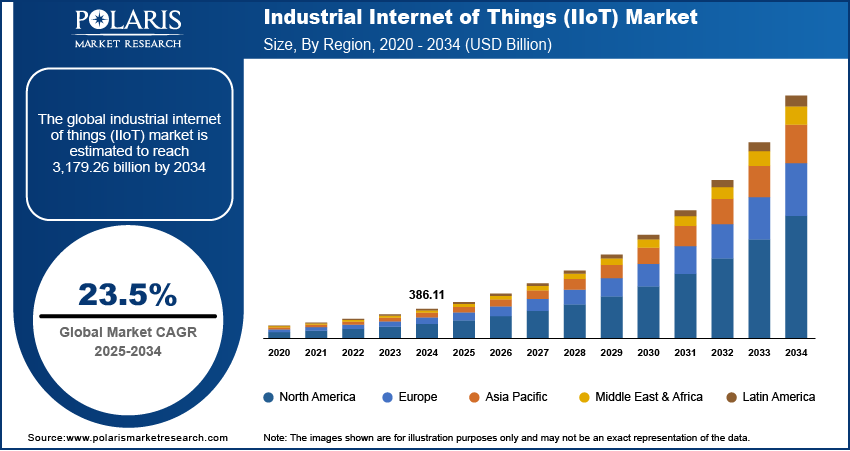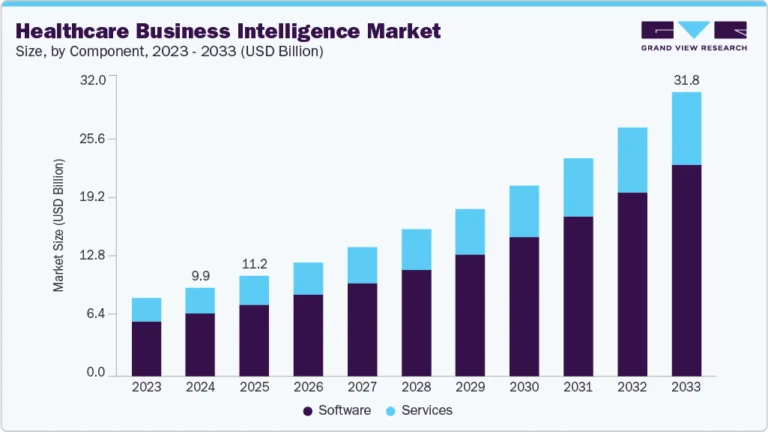Industrial Internet of Things (IIoT) Market Expected to Reach USD 3,179.26 Billion by 2034, Growing at a CAGR of 23.5%

The Industrial IoT market was valued at USD 386.11 billion in 2024 and is projected to grow from USD 475.18 billion in 2025 to USD 3,179.26 billion by 2034, registering a robust CAGR of 23.5% during the forecast period.
Key Market Trends & Insights
- Edge Computing and Real-Time Analytics: The increasing use of edge devices is allowing real-time data processing closer to the source, reducing latency and improving decision-making in mission-critical industrial applications.
- Integration of AI and Machine Learning: AI is being embedded into IIoT systems to automate operations, predict failures, and optimize asset performance through pattern recognition and intelligent analytics.
- Rise of Digital Twins: The use of digital twin technology is gaining traction for simulating industrial environments, enabling predictive maintenance, process optimization, and cost reductions.
- 5G-Driven Connectivity Expansion: With the rollout of 5G, industries are experiencing more reliable and faster connectivity, critical for enabling dense IIoT ecosystems, especially in remote and high-speed environments.
Market Size Insights
- 2024 Market Value: USD 386.11 billion
- 2025 Forecast: USD 475.18 billion
- 2034 Forecast: USD 3,179.26 billion
- CAGR (2025–2034): 23.5%
Request for Free Sample:
Market Overview
The Industrial Internet of Things (IIoT) is transforming traditional industrial operations by integrating connected devices, intelligent analytics, and automation into existing systems. IIoT enables real-time data exchange between machines, systems, and people, improving operational efficiency, reducing downtime, and enhancing predictive maintenance capabilities. It plays a critical role in smart manufacturing, logistics, energy management, and other industrial domains.
As industries increasingly prioritize digitization and smart infrastructure, the demand for IIoT solutions has surged across sectors like manufacturing, oil & gas, transportation, and energy. The convergence of cloud computing, edge analytics, AI, and 5G technologies is accelerating the adoption of IIoT platforms, fostering innovation, productivity, and real-time decision-making. Companies are investing heavily in IIoT to gain a competitive edge through automation and intelligence.
Key Market Growth Drivers
- Rising Adoption of Smart Manufacturing and Industry 4.0 Initiatives: Increasing focus on automation and operational efficiency is driving widespread deployment of IIoT across manufacturing plants.
- Government Support for Industrial Digitization: Policies and funding from governments worldwide are promoting smart factories and digital infrastructure.
- Proliferation of Connected Devices: Rapid growth in the number of sensors and IoT-enabled machinery is fueling real-time industrial monitoring and control.
- Demand for Predictive Maintenance: Businesses are adopting IIoT to prevent costly equipment failures and unplanned downtime through continuous monitoring.
Market Challenges
- Cybersecurity Threats: The increased connectivity of industrial systems poses heightened risks of cyberattacks and data breaches, making security a top concern.
- Complex Integration with Legacy Systems: Integrating IIoT with outdated industrial machinery and software can be technically challenging and expensive.
- High Initial Investment: The cost of deploying IIoT infrastructure, including sensors, connectivity solutions, and platforms, can be prohibitive for small to mid-sized enterprises.
- Data Overload and Management Issues: Managing and analyzing vast volumes of data generated by IIoT systems requires robust infrastructure and skilled personnel.






